The Best Business Carbon Footprint Calculators: Our Top 10 Picks
.png)
If you are searching for the best carbon footprint calculator for business, it is easy to get lost in a sea of tools, free trials, and jargon. You know you need to understand your impact, probably to satisfy customers, investors, or accreditations like EcoVadis or B Corp. The challenge is choosing a calculator that matches your size, budget, and time.
Below is a quick guide to business carbon accounting, followed by our pick of the top 10 carbon emission calculators for businesses.
Introduction to carbon measurement
A business carbon footprint is the total climate impact of your operations over a year. It includes direct emissions from fuel and on-site equipment (Scope 1), purchased electricity and heat (Scope 2), and wider greenhouse gas emissions in your value chain such as commuting, purchased goods, logistics, and waste (Scope 3) - read more on the Scopes.
A good carbon footprint calculator takes your activity and spend data, combines it with recognised emission factors, and converts everything into carbon dioxide equivalent (CO₂e) so you can see a single, comparable number. Once you have a solid view of your current carbon footprint and broader organisational footprint, you can prioritise reductions, set targets, and report credibly to stakeholders.
The main types of business carbon footprint calculators
Most business carbon footprint calculators fall into three groups:
- First, there are simple online tools that allow you to measure your carbon footprint in a few minutes.
- Second, you have software platforms with a free tier, where a structured carbon footprint calculator walks you through data collection and provides better coverage of your operations, sometimes with paid upgrades.
- Finally, there are paid-only platforms that do not offer the ability to sign up and calculate an initial carbon footprint for free. These often focus more on enterprise-sized businesses.
In this list, we'll focus on the first two buckets - that is, carbon calculators that allow you to input data for free (even if full access requires you to upgrade), and measure your carbon footprint immediately.
What makes a good business carbon footprint calculator?
Every business is different, and requirements will vary depending on size, sector and stage of journey. But for most businesses - especially those without a dedicated sustainability team - a good carbon footprint tool should:
- Be intuitive and guide you through data collection without assuming you are a climate expert.
- Offer at least a free carbon footprint calculator or low-cost entry level so you can test it before fully committing.
- Under the bonnet, align methodologies with the GHG Protocol (the carbon accounting gold standard), and use reputable emission factors (for example, from DEFRA or similar).
- Cover all material carbon emissions, not just simple areas like fuel usage, electricity and travel.
- Finally, the best tools help you move from measurement to action by highlighting hotspots in your carbon emissions, suggesting next steps, and supporting planning rather than simply exporting a static report.
In our list, we've tested and ranked carbon footprint calculators across these key criteria, so that you don't have to!
Our top 10 picks: the best calculators to measure your carbon emissions
Below are ten tools we see most often in conversations. We have kept the focus on ease of use, relevance for small to mid-sized organisations, and support with turning results into action.
1. Seedling – Business Carbon Footprint Calculator
Seedling is a carbon management platform built specifically for small and mid-sized businesses. It combines an intuitive business carbon footprint calculator with one-to-one expert support.
Seedling guides you through collecting emissions data from across your business, using activity-based calculations where possible instead of relying purely on spend. The platform applies robust factors to build a full-scope profile, covering Scopes 1, 2, and 3. That includes common categories like fuel, purchased electricity, materials, logistics, business travel, commuting, and homeworking.
Once your impact is mapped, you can:
- Analyse results by scope, category, and location.
- Model different reduction actions using an integrated planning engine.
- Set Net Zero targets and build a practical plan.
- Generate the reporting you need, from GHG inventories to public sector Carbon Reduction Plans and B Corp Climate Transition Plans.
Crucially, every client gets a dedicated adviser who helps with data gaps, methodology, and turning numbers into real-world action.
How it scores for SMEs
- Ease of use: Strong
- Cost for SMEs: Strong (including a useful free carbon footprint calculator to get started)
- Data & emission factors: Strong
- Scope coverage: Strong (full organisational footprint, including value-chain greenhouse gas emissions)
- Reduction & Net Zero support: Strong
Who it’s good for
Businesses that want a practical business carbon calculator with hands-on support. Ideal if you are working toward B Corp, client reporting, or tenders, and need confidence in both your numbers and your reduction plan.
2. SME Climate Hub – simple starter tool
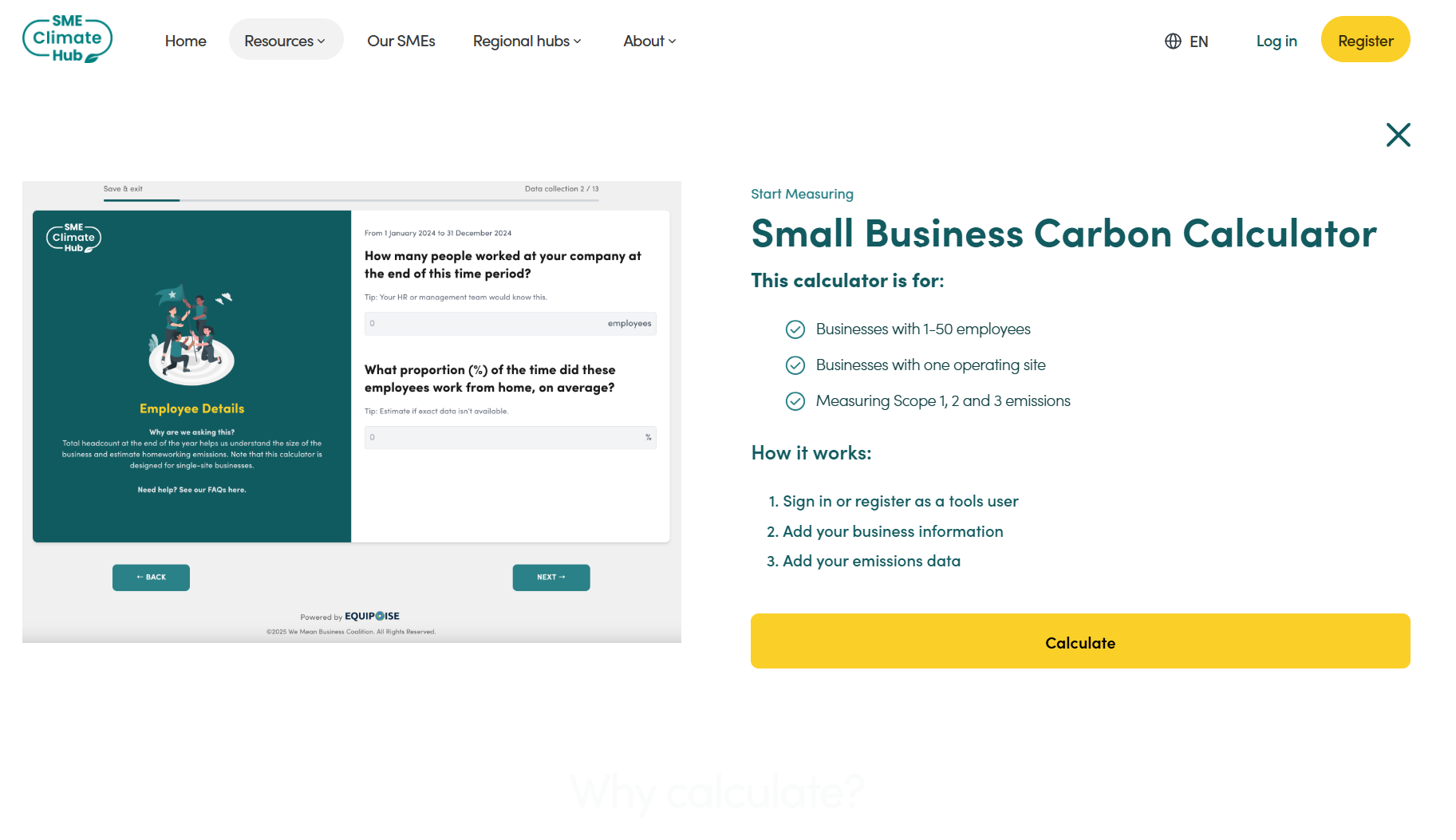
The SME Climate Hub offers a very simple free carbon footprint calculator alongside its climate commitment resources. The tool is designed to give SMEs a quick estimate of their impact and to encourage public Net Zero commitments.
You enter a small set of numbers – typically energy use, staff numbers, and a few activity metrics – and the tool returns an estimated result. It uses standard factors, but the methodology is intentionally streamlined.
How it scores for SMEs
- Ease of use: Strong
- Cost for SMEs: Strong (free)
- Data & emission factors: Average (fine for estimates, less suited for audited reporting)
- Scope coverage: Average (limited data inputs, less control over Scope 3 categories)
- Reduction & Net Zero support: Weak (resources rather than hands-on planning)
Who it’s good for
Smaller businesses taking their first step into measurement and wanting a quick, no-cost way to start internal conversations.
3. CarbonFootprint.com – Carbon Footprint Calculator
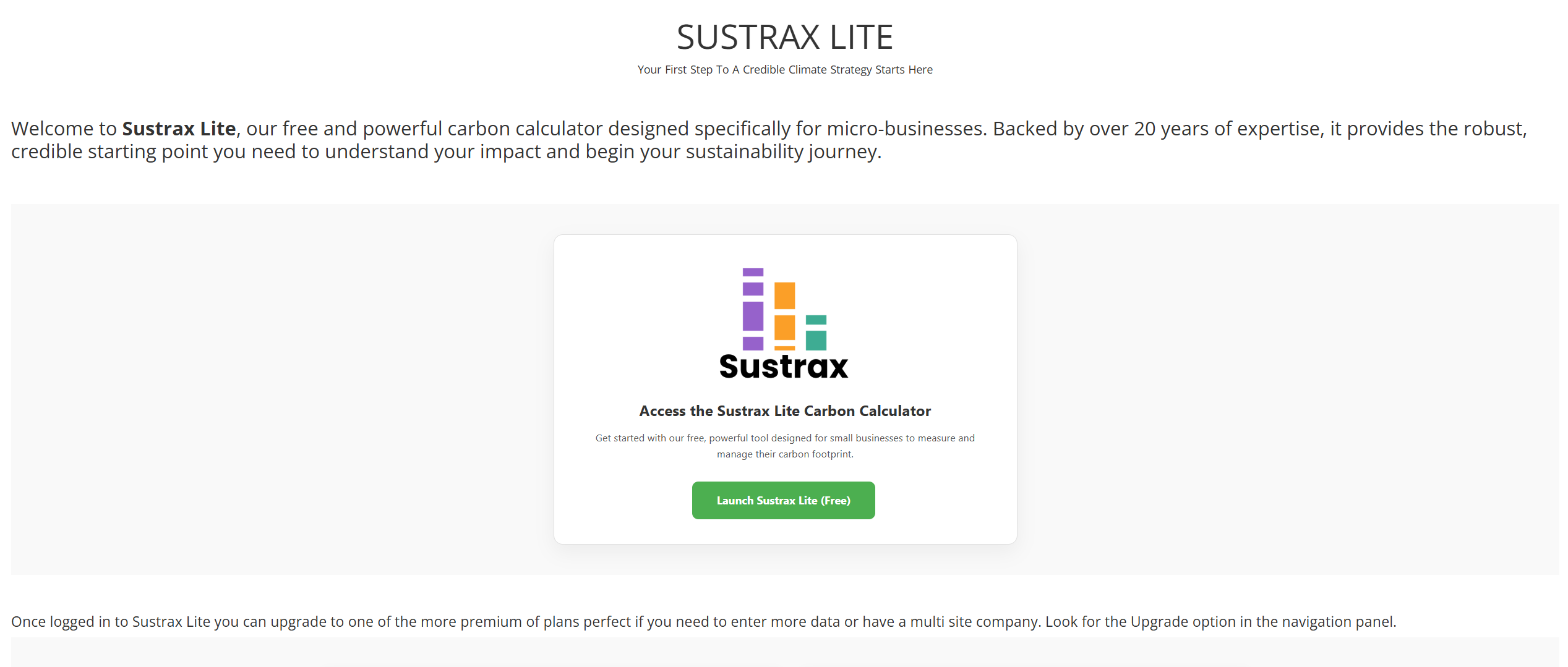
CarbonFootprint.com offers a well-known online calculator "Sustrax" alongside a consultancy service. Their tools allow you to enter fuel, energy, and travel data and receive a fairly detailed result.
The calculator is easy enough to use for basic categories, and the site offers additional tools for specific activities. For more nuanced Scope 3 categories or complex organisations, you are typically directed toward their paid consultancy.
How it scores for SMEs
- Ease of use: Average (web interface is simple, but assumes some familiarity with terminology)
- Cost for SMEs: Average (basic use is free, deeper work quickly shifts into consultancy)
- Data & emission factors: Strong
- Scope coverage: Average (good for energy and travel, patchier on wider value-chain activities)
- Reduction & Net Zero support: Average (ad-hoc advice rather than integrated planning workflow)
Who it’s good for
SMEs that want a credible online option for energy and travel, and are comfortable managing wider Scope 3 categories themselves or with an external consultant.
4. Carbon Trust – SME tools and guidance
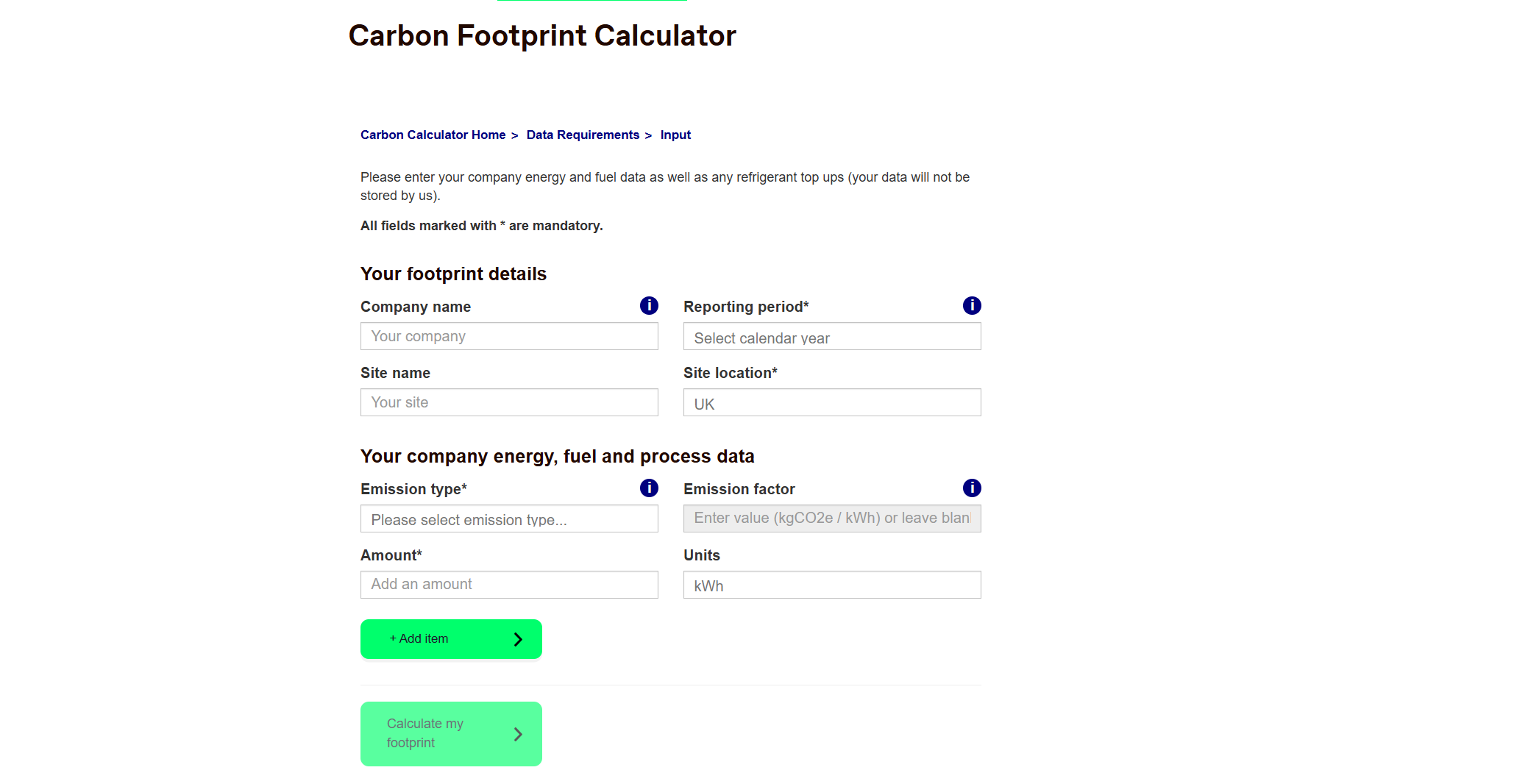
The Carbon Trust provides guidance and tools for measurement, including spreadsheets and online support for smaller organisations. Rather than a single “click-and-go” calculator, they provide structured templates backed by strong technical methodology.
This effectively turns their resources into a high-quality toolkit for teams that are confident working with spreadsheets and more detailed data.
How it scores for SMEs
- Ease of use: Average (excellent guidance, but assumes time and some internal capability)
- Cost for SMEs: Strong (many resources are free, but tailored support is consultancy-priced)
- Data & emission factors: Strong
- Scope coverage: Strong (if you work through the templates carefully)
- Reduction & Net Zero support: Average (good strategic guidance, less step-by-step execution for smaller teams)
Who it’s good for
SMEs with an internal sustainability lead or QHSE manager who is comfortable working with technical documentation and wants a robust, template-based approach to their impact.
5. NatWest – Carbon Planner
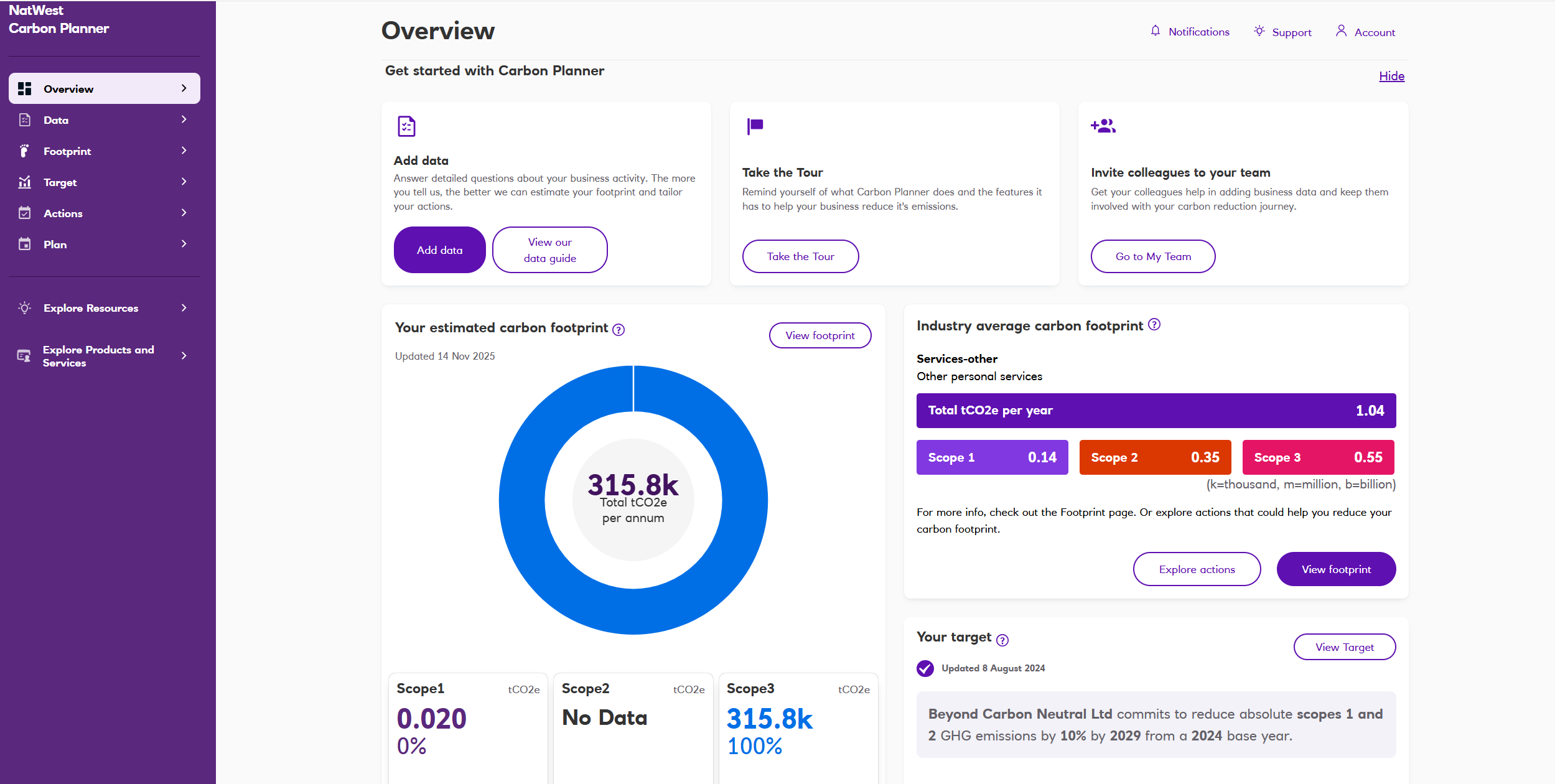
NatWest’s Carbon Planner is a digital tool aimed at its business banking customers, but usable by anyone. It helps SMEs understand their impact and identify potential cost and carbon savings.
The planner offers a guided journey through energy, transport, and some operational activities. It uses embedded calculations to estimate your profile, then suggests changes such as switching to lower-carbon vehicles or improving building efficiency.
How it scores for SMEs
- Ease of use: Strong
- Cost for SMEs: Strong (free for eligible customers)
- Data & emission factors: Average (solid but focused on a subset of operations)
- Scope coverage: Average (strong on energy and transport, weaker for complex Scope 3 categories)
- Reduction & Net Zero support: Strong (detailed action planner with advice, costings etc)
Who it’s good for
UK SMEs that want a quick way to measure emissions and a business-friendly planning tool focused on operational impacts and cost savings.
6. Persefoni – enterprise-grade platform with a basic free calculator

Persefoni is a large, enterprise-focused climate platform. On the marketing side, it also offers a simplified, free business calculator to give companies a quick estimate.
Behind the scenes, the full platform is a more advanced business carbon calculator: a sophisticated system designed for corporates with complex reporting needs, often under regulations like SEC, CSRD, or ISSB.
For SMEs, the gap between the simple online tool and the full platform is significant.
How it scores for SMEs
- Ease of use: Average (simple online tool is easy; full platform is complex)
- Cost for SMEs: Weak (enterprise pricing and implementation for the full product)
- Data & emission factors: Strong
- Scope coverage: Strong (in the enterprise product, assuming you configure it fully)
- Reduction & Net Zero support: Average (great analytics, but geared to larger teams with in-house expertise)
Who it’s good for
Larger mid-market or enterprise organisations needing detailed reporting and governance. For most SMEs, Persefoni will be over-specified once you move beyond the introductory calculator.
7. Greenly – 2-minute business carbon calculator
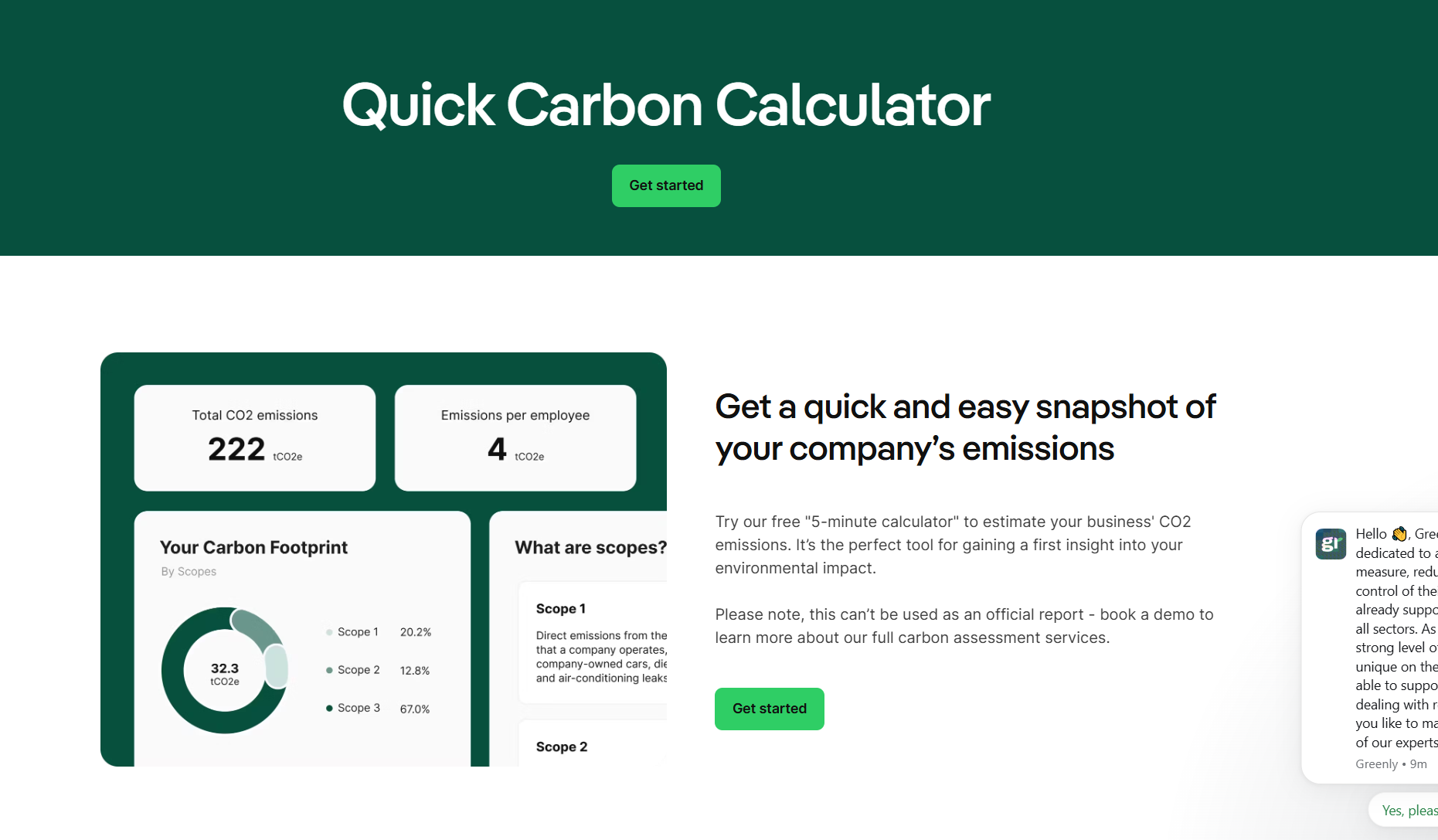
Greenly offers a “2-minute” online calculator for businesses, usually as a lead-in to its broader platform. The short tool is quick and engaging, using high-level questions to estimate your impact across energy, travel, and operations.
Like Persefoni, Greenly’s core product is closer to an enterprise-grade reporting solution. While the front-end experience is simple and accessible, moving from the free estimate to a full paid plan can feel like a big jump for smaller businesses.
How it scores for SMEs
- Ease of use: Strong (for the 2-minute calculator)
- Cost for SMEs: Average/Weak (free starter, but ongoing platform costs are often higher than SME-focused tools)
- Data & emission factors: Strong
- Scope coverage: Average on the quick calculator, Strong on the full platform
- Reduction & Net Zero support: Average (for the free tool, Strong on the full platform
Who it’s good for
Growing companies that want a quick way to measure emissions now and anticipate scaling into a more complex platform later. For many SMEs, the pricing and configuration effort of the full suite will feel heavy compared to more focused solutions like Seedling.
8. CoolClimate Network – Small Business Calculator
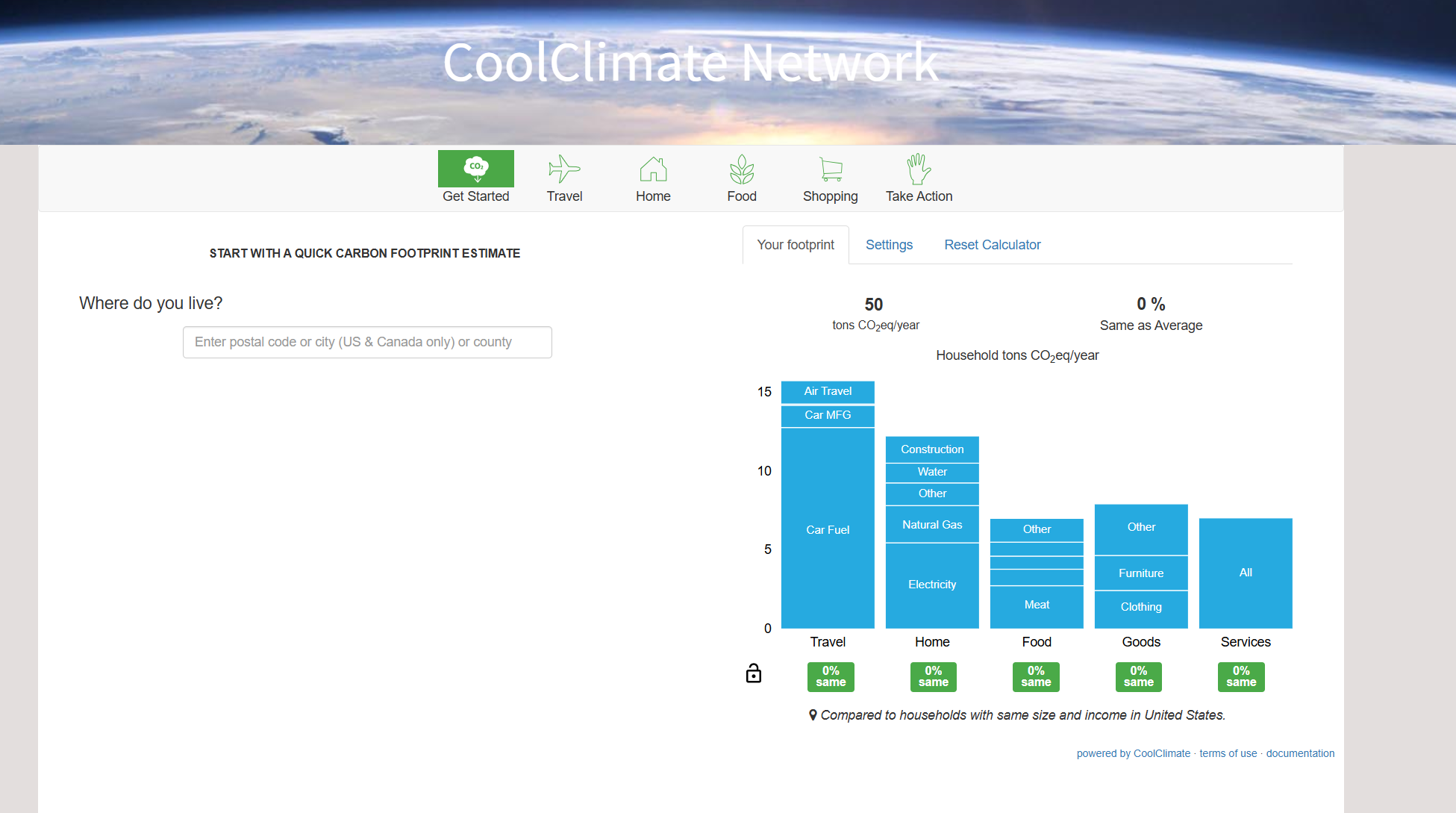
The CoolClimate Network (from UC Berkeley) provides a calculator that has been widely used as an educational tool. It focuses on activity data across energy, travel, and purchasing, and is particularly useful for understanding the drivers of your emissions profile.
The interface is more technical than some modern SaaS tools, but for a free option it is still a solid choice.
How it scores for SMEs
- Ease of use: Average (clear, but a bit dated)
- Cost for SMEs: Strong (free)
- Data & emission factors: Average/Strong (robust, but more US-centric)
- Scope coverage: Average (good spread, but may not map perfectly to your reporting needs)
- Reduction & Net Zero support: Weak (limited planning features within the tool itself)
Who it’s good for
Smaller organisations - particularly those in the US - that want a free calculator to measure their impact in more depth than a simple quiz, and are comfortable interpreting results themselves.
9. GHG Protocol tools – spreadsheets for full-scope measurement
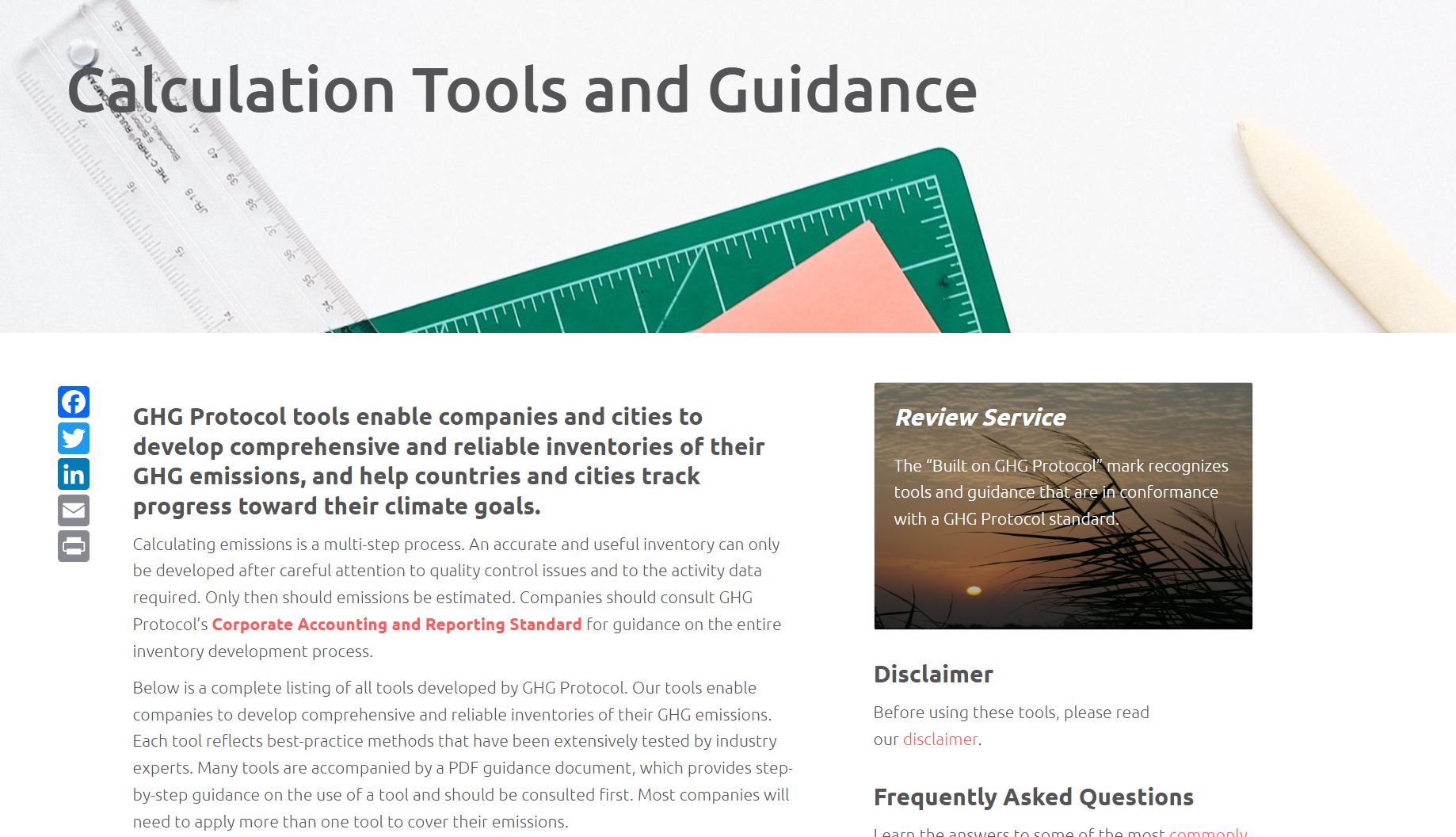
The GHG Protocol provides calculation tools and guidance that can be used as a comprehensive toolkit, especially if you are comfortable with spreadsheets.
These tools help you convert activities and spend into carbon dioxide equivalent across many categories, from fuel and purchased electricity to logistics and waste. Used carefully, they support a robust inventory aligned with global standards.
However, they are not a plug-and-play web app. You need time, attention to detail, and at least some prior understanding of carbon accounting.
How it scores for SMEs
- Ease of use: Weak/Average (very detailed, but not intuitive or “software-like”)
- Cost for SMEs: Strong (freely available)
- Data & emission factors: Strong
- Scope coverage: Strong (excellent for full-scope work)
- Reduction & Net Zero support: Weak (no built-in planning – it is all about measurement)
Who it’s good for
SMEs with a sustainability lead or QHSE manager who wants maximum alignment with standards and is comfortable using spreadsheets to measure carbon emissions as their main tool.
10. Simple in-house spreadsheet calculators
Some SMEs start with their own calculators in Excel or Google Sheets. These typically combine:
- Energy and fuel data.
- Some travel and logistics figures.
- A library of emission factors copied from DEFRA or similar sources.
Done well, this can form a basic small business carbon calculator and a stepping stone to something more advanced. Done badly, it can lead to inconsistent or unreliable results.
How it scores for SMEs
- Ease of use: Average (depends on who builds it)
- Cost for SMEs: Strong (near-zero cash cost, higher time cost)
- Data & emission factors: Average/Weak (depends how often they are updated)
- Scope coverage: Average (often limited to energy, fuel, and some travel)
- Reduction & Net Zero support: Weak (you will need to bolt on your own action planning)
Who it’s good for
Teams that need a temporary solution to measure emissions while they research dedicated tools. If your spreadsheet starts to feel like a fragile home-made platform, it is usually time to move to software designed for the job.
Summary: picking the right calculator for your stage
There are plenty of tools that call themselves a business carbon footprint calculator, from quick free quizzes to heavyweight enterprise platforms. The right one depends on where you are in the journey, how much time you have, and how robust your reporting needs to be.
For a first estimate, something like SME Climate Hub can be enough; for full-scope reporting and ongoing reduction, a platform such as Seedling helps you go deeper, with human support and pricing designed for smaller organisations.
With Seedling you can start on a free plan, test the process with your own data, then upgrade when you are ready for full access and one-to-one guidance, rather than jumping from a simple tool to an enterprise system that is too complex and costly for an SME.
Get in touch here and see how Seedling can help you to easily calculate your carbon footprint.
Start Measuring Your Carbon Footprint Free Today
Free forever. No Credit Card required.
Benchmark your business’s climate action for free

Chat to an expert

Measure a full-scope footprint, reduce emissions, and share your Net Zero strategy.




.svg)


